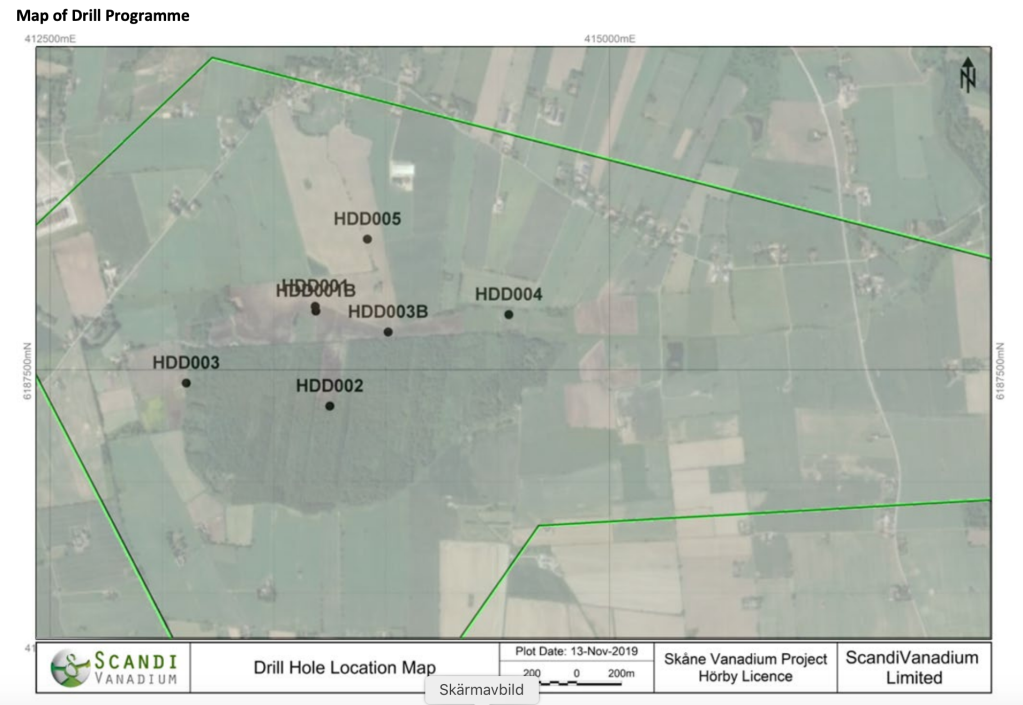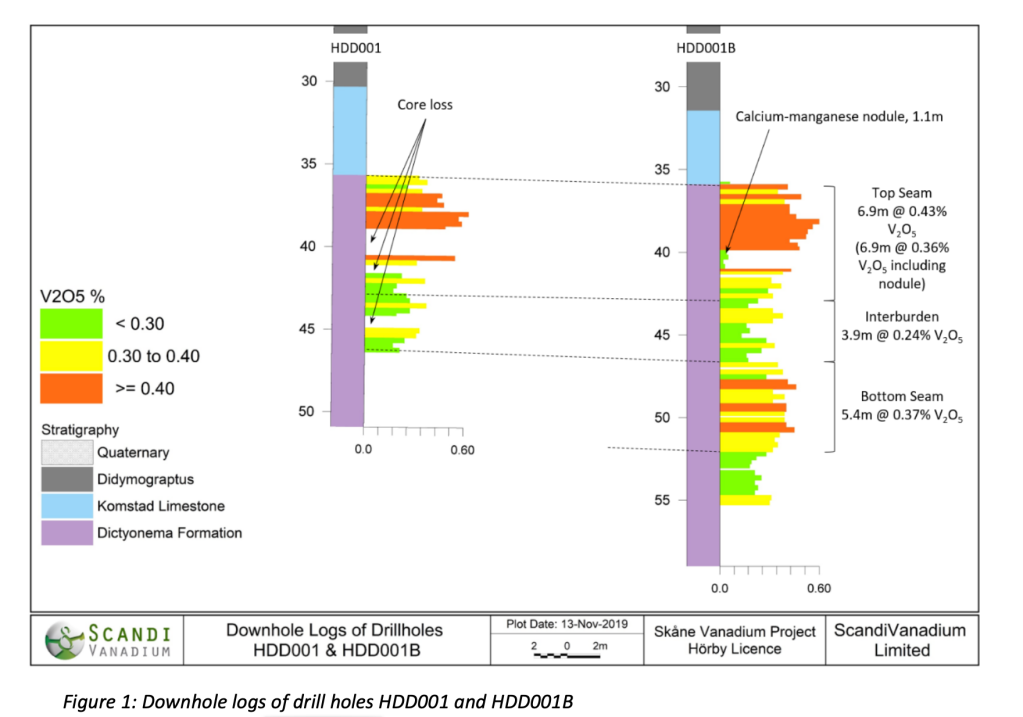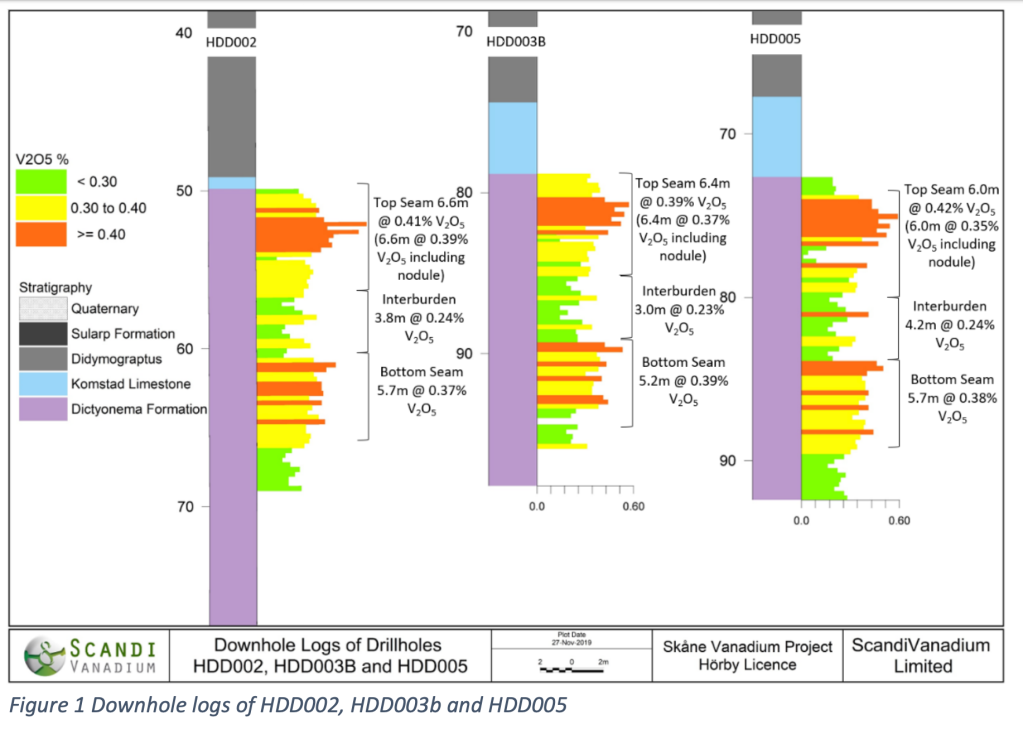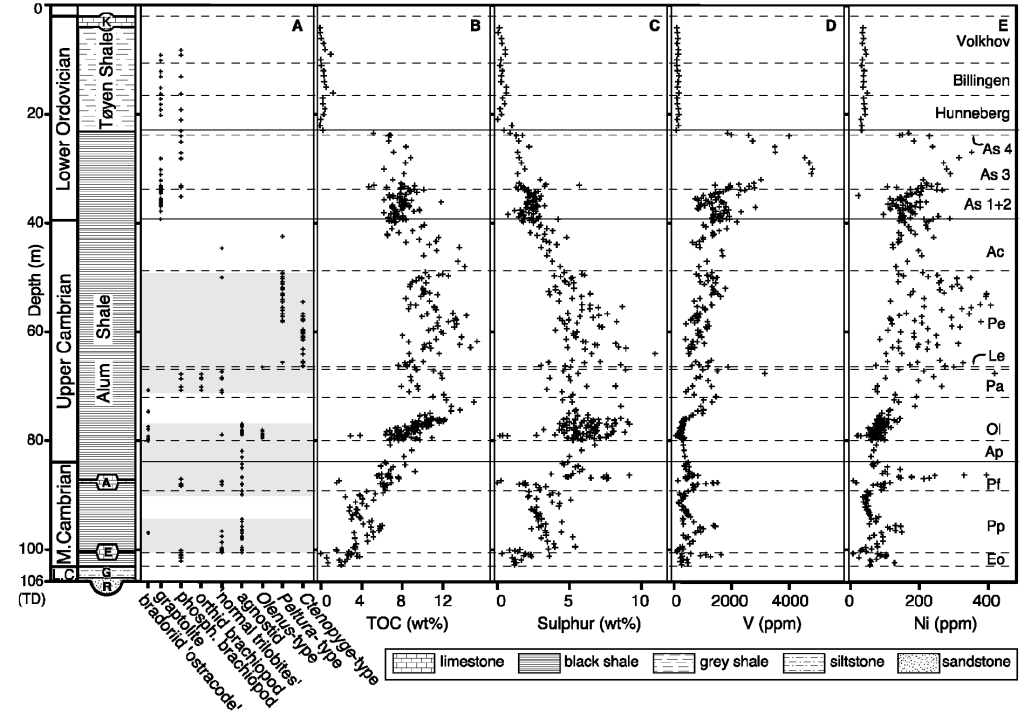About two months ago, I commented on ScandiVanadium’s drilling in Lybymosse and suggested that the extended drilling program (including additional drill holes) might be due to the fact that the company had encountered difficulties and that they might not have hit their target, the uppermost part of the Alum shale, or what is generally referred to as ‘Dictyonema shale or Formation’.
I now need to revise my former assumption, since the analytical results of the drill cores show that the uppermost part of the Alum shale, the ‘Dictyonema shale’, is indeed present in some of ScandiVanadium’s new cores.
Recently the company published two ASX Announcements, one dating November 14, 2019 and another dating November 29, 2019. The first announcement details analytical results of drill holes HDD001 and HDD001B and the second announcement the analytical results of drill holes HDD002, HDD003B, and HDD005. The position of the different drill holes is quite a bit different from the picture I showed earlier and which was based on ScandiVanadium’s original working plan. Obviously, the company moved drill hole locations, also added an additional drill hole, HDD001B, and renamed the various drill cores differently than in the original working plan. This makes it a bit difficult to follow all the whereabouts of ScandiVanadium.

In any case and as shown on the figure above, seven drill cores now exist for Lybymosse, and analyses have been presented for five of these (more about these analyses in a follow up blog contribution). In the ASX Announcement of November 29, 2019, the company writes that five drill cores (HDD001, HDD001B, HDD002, HDD003B and HDD005) intersected (= reached) the ‘Dictyonema Formation’. This would mean that the ‘Dictyonema shale’ was not found in holes HDD003 and HDD004 further to the west and east. Reasons for this could be that this part of the Alum shale has been eroded and therefore is no longer present, or that it is found in considerable depth due to tectonic movements. But it also means that the target layer is not evenly distributed in the area and that more drill holes are needed to better confine the area where a mine could possibly be opened in the future.
Cores HDD001 and HDD001B are located close to core Lyby-1, which was reported by Erlström et al. (2001). I discussed this core already earlier since Erlström et al. (2001) write that the whole Alum Shale interval (35.5-55 m) present in their drill core can be correlated to the upper Cambrian. Note that what is generally considered the ‘Dictyonema shale’ (or Dictyonema Formation) belongs in time to the next younger geological time period, the Ordovicium, and more specifically to the lowermost part of the Ordovicium.
In their ASX Announcement, ScandiVanadium now write that the ‘Dictyonema Formation’ (or shale) starts at 35.5 m in the Lyby-1 core and at 35.7 m in cores HDD001 and HDD001B, thus at a similar depth. This made me pretty confused, especially since the article by Erlström et al. (2001) does not even mention the ‘Dictyonema shale’. And now ScandiVanadium write that everything recovered below 35.7 m relates to the ‘Dictyonema Formation’ (or shale).
So I asked one of my Alum shale colleagues for advise. The answer I got was that the ‘Dictyonema shale’ (uppermost part of the Alum shale formation) cannot be separated from the rest of the Alum shale using only lithological parameters. Without detailed analyses of the fossils (so-called graptolites) in the shale, the boundary between the ‘Dictyonema shale’ and the underlying shale cannot be determined. My colleague felt pretty confident that the ‘Dictyonema shale’ was reached in ScandiVanadium‘s Lyby cores, but that its thickness remains unclear in Lyby.
The ‘Dictyonema shale’ (purple color in the two figures below) generally reaches a thickness of around 10-15 m in Skåne. The purple columns in the two figures below however represent a core length of between 15 and 30 m. I therefore draw the conclusion that the purple columns in ScandiVanadium‘s Lyby cores not only represent the ‘Dictyonema shale’ (i.e. the lower Ordovicium) as stated in the figure legend, but also parts of the Cambrian Alum shale.

So what actually is the ‘Dictyonema shale’ (or Dictyonema Formation as ScandiVanadium write)? Many talk about it now since ScandiVanadium appeared in Skåne and it has become a common term, especially in Österlen. Is the ‘Dictyonema shale’ a separate and special rock type? Is it an Alum shale or something completely different? Let’s look at the various definitions and terminologies.
According to my Alum shale colleague the ‘Dictyonema shale’ is an Alum shale and forms part of the Alum shale Formation. The only way to distinguish it from other Alum shale ‘sub-units’ is by analyzing its fossil content. But – are there other ways that distinguish this uppermost part of the Alum shale from its older part?
To check this up, I went back to the paper by Schovsbo (2001) and searched for the term Dictyonema in his article. I did not find a single mentioning of Dicyonema in the paper, except for in the reference list. The only thing that Schovsbo (2001) shows, using the Gislövshammar-2 drill core (see the black and white figure further below), is that the part of the Alum shale with high Vanadium content belongs to the lower Ordovicium. Nothing more. I then checked the detailed and very nice summary of eastern Skåne’s geology by Eriksson (2012). And there I found an answer! The term ‘Dictyonema shale’ (it certainly is not a Formation as ScandiVanadium always write) refers to what Eriksson (2012) calls ‘traditional names’, that is an old terminology that is no longer in use in the scientific literature.
ScandiVanadium also state that the rocks in the cores were classified in accordance with earlier geological work in the area and with advise from geologists Niels Schovsbo and Arne Nielsen from the University of Copenhagen. I just wonder why these two geologists, who obviously are Alum shale experts, did not explain to ScandiVanadium that it would be better to name things for what they are and to not use an old terminology.

Maybe it is time to label ScandiVanadium‘s ‘Dictyonema Formation’ for what it is: nothing else but Alum shale. By using the term ‘Dictyonema Formation’ ScandiVanadium gives the impression that this rock type or rock layer interval is different and separated from the Alum shale. But it is not.
As shown in Schovsbo’s (2001) figure below, the only differences that can be seen between the uppermost part of the Alum shale and the middle and lower parts are: a) that certain important fossils allow separating between the older, middle and upper part of the Alum shale (column A) and b) that organic carbon (TOC), Sulphur, Vanadium (V) and Nickel (Ni) (columns B-E) show distinct variations between lower and higher values, which partly overlap with the fossil zones, and partly do not overlap with these zones.

The high Vanadium values thus occur in a certain interval within the uppermost part of the Alum shale. This interval belongs to the geological time period called Ordovicium and more specifically, to parts of the Ordovician Stage termed ‘Tremadocian‘. Thus, it is better to name the ‘Dictyonema Shale’ or ‘Dictyonema Formation’ in a correct way: the Tremadocian Alum shale. Such a term can’t really be more difficult to use than ‘Dictyonema Shale’ or ‘Dictyonema Formation’?!
References cited
Eriksson, M. (2012): Stratigraphy, facies and depositional history of the Colonus Shale Trough, Skåne, southern Sweden. Dissertations in Geology at Lund University,
Master’s thesis, no 310.
Erlström, M., Ahlberg, P. & Löfgren, A. (2001): Lower Palaeozoic stratigraphy at Lyby and Tängelsås, central Scania, southern Sweden. GFF, Vol. 123, pp. 7–14. https://www.researchgate.net/publication/233339018_Lower_Palaeozoic_stratigraphy_at_Lyby_and_Tangelsas_central_Scania_southern_Sweden
Schovsbo, N. H. (2001): Why barren intervals? A taphonomic case study of the
Scandinavian Alum Shale and its faunas. Lethaia, Vol. 34, pp. 271–285.


Pingback: Much less than expected? | Barbara Wohlfarth